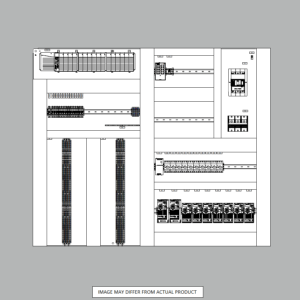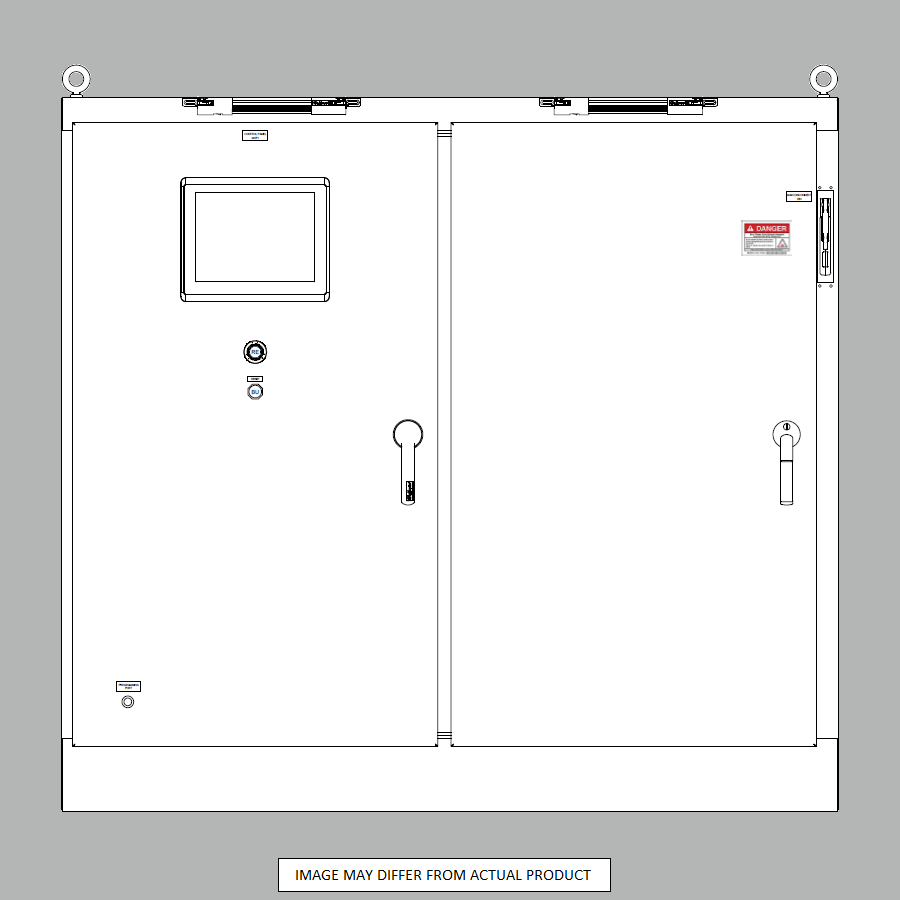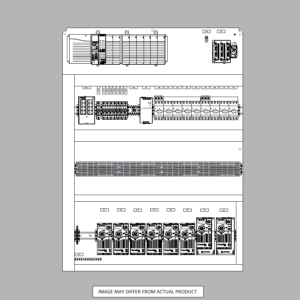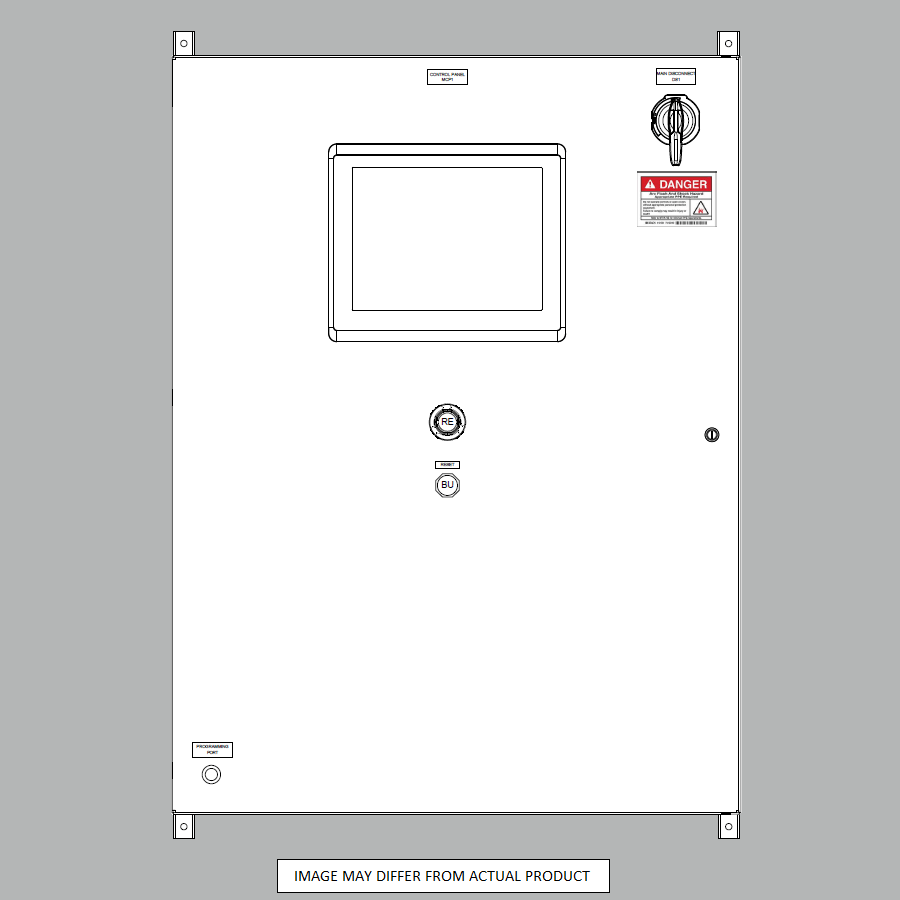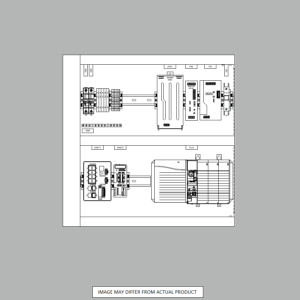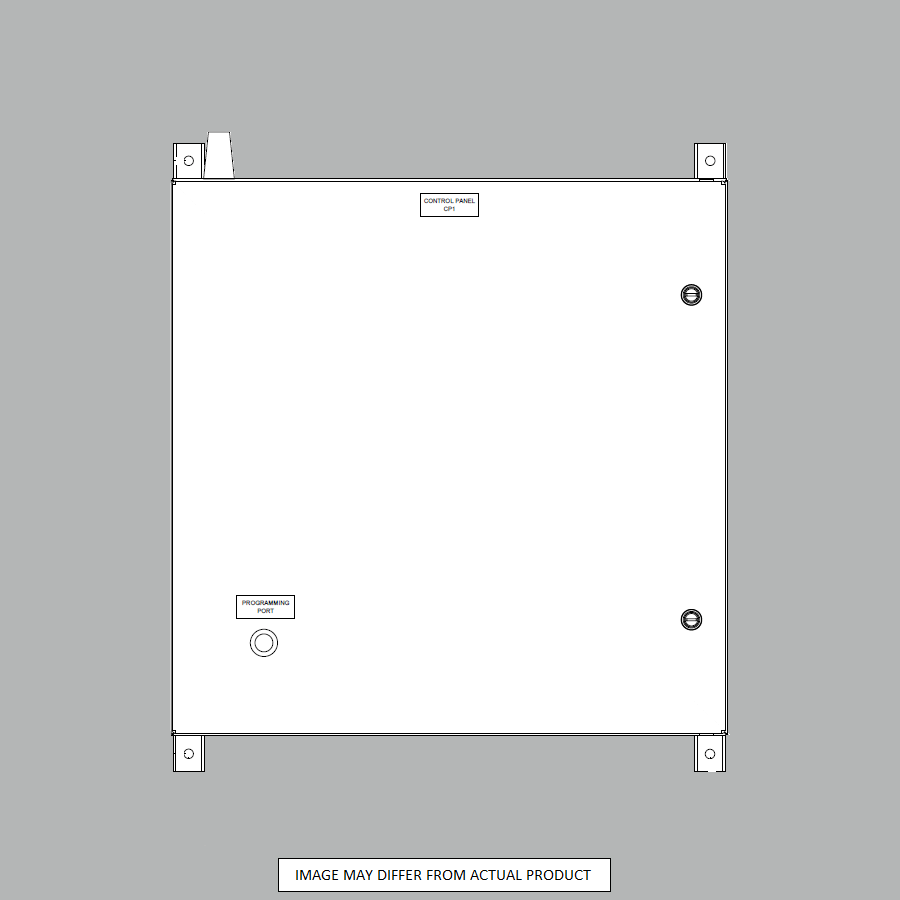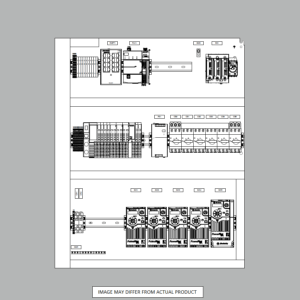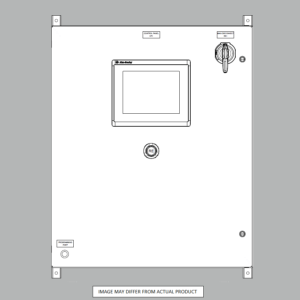What is a VFD or Variable Frequency Drive?
A Variable Frequency Drive (VFD) is a type of motor controller that drives an electric motor by varying the frequency and voltage supplied to the motor. VFDs are crucial in modern industry, offering significant advantages in energy efficiency, motor control, and operational flexibility. This article will explore the fundamentals of VFDs and their applications.
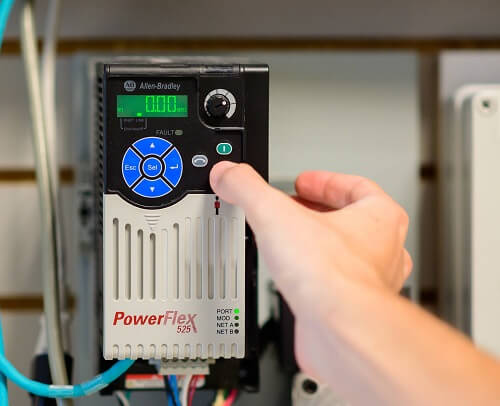
Allen-Bradley Powerflex 525 VFD
Introduction to Variable Frequency Drive or VFDs
What does VFD stand for?
VFD stands for Variable Frequency Drive, also known as an adjustable frequency drive or AC drive. This sophisticated motor controller varies the frequency and voltage supplied to an electric motor, allowing for precise control of motor speed and torque. VFDs are essential in applications where motor speed needs to be adjusted to meet specific requirements, offering a more efficient alternative to running motors at full speed continuously.
The importance of VFDs in modern industry cannot be overstated. They play a crucial role in optimizing motor performance, reducing energy consumption, and extending equipment life. By allowing motors to run at variable speeds, VFDs enable systems to operate more efficiently, adapting to changing load conditions and minimizing wear and tear on mechanical components.
Why are VFDs important in modern industry?
VFDs have become indispensable in modern industry due to their ability to significantly reduce energy consumption and improve overall system efficiency. By controlling the frequency and voltage supplied to electric motors, VFDs allow for precise speed control, which is particularly valuable in applications with varying load requirements. This flexibility translates into substantial energy savings, as motors can operate at optimal speeds rather than constantly running at full speed.
Furthermore, VFDs offer advantages in terms of motor control and protection. They provide soft starting capabilities, eliminating the “instant shock” associated with across-the-line starting, which can extend motor life and reduce mechanical stress on the system. Additionally, VFDs often incorporate features such as phase protection and harmonic mitigation, further enhancing the reliability and performance of electric motor systems.
How Does a VFD Work?
What are the main components of a VFD?
A typical VFD consists of several key components that work together to control the frequency and voltage supplied to an electric motor. The main components include a rectifier, which converts AC power to DC; a DC bus, which stores and filters the rectified power; and an inverter, which converts the DC power back to AC at the desired frequency. Additionally, VFDs incorporate control circuitry and user interfaces for programming and monitoring.
The rectifier in a VFD can be either a simple diode bridge for basic applications or a more advanced active front end for improved power quality. The DC bus uses capacitors to smooth out the rectified voltage, while the inverter typically employs Insulated Gate Bipolar Transistors (IGBTs) for efficient and precise switching. These components work in harmony to provide the variable frequency and voltage output required for optimal motor control.
How does a VFD control motor speed?
A VFD controls motor speed by adjusting the frequency of the power supplied to the motor. This is achieved through a process called pulse width modulation (PWM), where the inverter rapidly switches the DC voltage on and off to create a simulated AC waveform. By varying the width and frequency of these pulses, the VFD can effectively control the motor’s speed and torque.
The relationship between frequency and motor speed is linear in most applications. As the VFD increases the output frequency, the motor speed increases proportionally. This allows for precise control of motor speed across a wide range, typically from about 10% to 200% of the motor’s base speed. Additionally, VFDs can adjust the voltage in proportion to the frequency to maintain proper motor magnetization and torque production throughout the speed range.
What is the relationship between frequency and motor speed?
The relationship between frequency and motor speed in AC induction motors, which are commonly used with VFDs, is directly proportional. The speed of an AC motor is determined by the frequency of the power supply and the number of poles in the motor. This relationship is expressed by the formula: RPM = (120 × Frequency) / Number of Poles. For example, a four-pole motor running on 60 Hz power will have a synchronous speed of 1800 RPM.
By varying the frequency output of the VFD, the motor’s speed can be precisely controlled. Lowering the frequency reduces the motor speed while increasing the frequency raises it. This linear relationship allows for smooth and efficient speed control across a wide range. However, it’s important to note that when operating below the motor’s base frequency, the voltage must also be reduced proportionally to maintain proper motor magnetization and prevent overheating.
Types of VFDs
What are the different categories of VFDs?
VFDs can be categorized into several types based on their control methods and applications. The main categories include Voltage Source Inverters (VSI), Current Source Inverters (CSI), and Pulse Width Modulation (PWM) drives. VSI drives are the most common type, using a constant DC bus voltage and varying the switching pattern to control the output. CSI drives, on the other hand, maintain a constant current in the DC link and are typically used in high-power applications.
Another important distinction is between scalar control and vector control drives. Scalar control, also known as Volts/Hertz (V/Hz) control, is simpler and more economical, suitable for applications where precise speed control is not critical. Vector control drives, including Field Oriented Control (FOC) and Direct Torque Control (DTC), offer superior performance and accuracy, making them ideal for applications requiring precise speed and torque control across a wide range of operating conditions.
How do pulse width modulation (PWM) drives work?
Pulse Width Modulation (PWM) drives are the most common type of VFDs used in modern applications. They work by rapidly switching the DC bus voltage on and off to create a simulated AC waveform. The width of these pulses is modulated to control the average voltage and frequency supplied to the motor. PWM drives typically operate at switching frequencies between 2 kHz and 20 kHz, with higher frequencies resulting in smoother motor operation but increased switching losses.
The PWM technique allows for precise control of both voltage and frequency, enabling efficient motor speed and torque control. By adjusting the pulse width and frequency, PWM drives can produce a near-sinusoidal current waveform in the motor, reducing harmonics and improving overall system efficiency. This method of control offers excellent performance across a wide speed range and is suitable for most induction motor applications, from simple pump and fan control to complex manufacturing processes.
What are the advantages of vector control drives?
Vector control drives, also known as Field Oriented Control (FOC) drives, offer several advantages over scalar control drives, particularly in applications requiring high-performance motor control. The primary advantage of vector control is its ability to independently control motor torque and flux, resulting in more precise speed regulation and faster dynamic response. This makes vector control drives ideal for applications such as machine tools, elevators, and electric vehicles, where accurate speed and torque control are critical.
Vector control drives also provide superior low-speed performance and full torque production even at zero speed, which is not possible with scalar control drives. They can maintain high efficiency across a wide speed range and offer better stability under varying load conditions. Additionally, vector control drives can provide accurate speed and position control without the need for encoder feedback in many applications, reducing system complexity and cost. These advantages make vector control drives the preferred choice for demanding industrial applications requiring precise motor control.
Applications of VFDs
Which industries commonly use VFDs?
VFDs are widely used across numerous industries due to their versatility and efficiency benefits. The manufacturing sector extensively employs VFDs in various processes, including conveyor systems, machine tools, and packaging equipment. In the oil and gas industry, VFDs are crucial for controlling pumps, compressors, and drilling equipment. The water and wastewater treatment sector utilizes VFDs for pump control, optimizing energy consumption in water distribution and treatment processes.
The HVAC industry is another major user of VFDs, implementing them in air handling units, cooling towers, and chiller systems to improve energy efficiency and maintain precise temperature control. In the mining and minerals processing industry, VFDs play a vital role in controlling conveyors, crushers, and grinding mills. Additionally, the renewable energy sector employs VFDs in wind turbines and solar power systems to optimize power generation and grid integration. These diverse applications demonstrate the widespread adoption of VFDs across various industrial sectors.
How are VFDs used in HVAC systems?
In HVAC systems, VFDs are primarily used to control the speed of fans and pumps, allowing for more efficient operation and improved temperature control. By adjusting the speed of these components based on actual demand, VFDs can significantly reduce energy consumption compared to traditional on/off or multi-speed systems. For example, in air handling units, VFDs can modulate fan speed to maintain consistent air pressure or flow rates, adapting to changing occupancy levels or environmental conditions.
VFDs are also employed in chiller systems to control compressor speed, optimizing cooling capacity and energy efficiency. In cooling towers, VFDs regulate fan speed to maintain desired water temperatures while minimizing energy use. Additionally, VFDs are used in pumping systems for both chilled and hot water distribution, allowing for variable flow rates that match the actual heating or cooling load. This application of VFDs in HVAC systems not only reduces energy costs but also improves overall system performance and extends equipment life by reducing wear and tear.
What role do VFDs play in manufacturing processes?
In manufacturing processes, VFDs play a crucial role in optimizing production efficiency and flexibility. They are extensively used to control the speed and torque of various types of machinery, including conveyors, mixers, extruders, and centrifuges. By allowing precise speed control, VFDs enable manufacturers to fine-tune their processes for different products or production rates without the need for mechanical adjustments or gear changes. This flexibility is particularly valuable in industries with diverse product lines or frequent changeovers.
VFDs also contribute to energy savings in manufacturing by allowing motors to operate at reduced speeds when full capacity is not required. For example, in a conveyor system, VFDs can adjust belt speed based on the actual load, reducing energy consumption during periods of low demand. In addition to energy efficiency, VFDs provide soft starting capabilities, reducing mechanical stress on equipment and extending its operational life. The ability to control acceleration and deceleration rates is particularly beneficial in applications involving high inertia loads or sensitive materials.
Benefits of Using VFDs
How do VFDs improve energy efficiency?
VFDs significantly improve energy efficiency by allowing motors to operate at variable speeds, matching their output to the actual load requirements. This is particularly beneficial in applications where the load varies over time, such as in HVAC systems or pumping operations. By reducing motor speed when full capacity is not needed, VFDs can dramatically decrease energy consumption. The relationship between speed and power consumption is cubic, meaning that even a small reduction in speed can result in substantial energy savings.
For example, running a motor at 80% of its full speed can reduce energy consumption by up to 50%. This efficiency improvement is achieved by eliminating the energy waste associated with throttling or bypass mechanisms used in constant-speed systems. Additionally, VFDs optimize the power factor of the motor, further enhancing overall system efficiency. The ability to soft-start motors also reduces peak demand charges and improves the power quality of the electrical system, contributing to overall energy efficiency improvements.
What are the cost savings associated with VFD implementation?
The implementation of VFDs can lead to significant cost savings in various aspects of industrial operations. The primary source of savings comes from reduced energy consumption, which can often result in a return on investment within 6 to 24 months, depending on the application and usage patterns. In many cases, energy savings of 20% to 50% are achievable, translating into substantial reductions in electricity costs. These savings are particularly pronounced in applications with variable loads or long operating hours.
Beyond energy savings, VFDs contribute to cost reductions through decreased maintenance requirements and extended equipment life. By providing soft starting and stopping capabilities, VFDs reduce mechanical stress on motors, belts, and other drive components, leading to fewer breakdowns and longer intervals between maintenance activities. Additionally, the precise control offered by VFDs can improve product quality and reduce waste in manufacturing processes, further contributing to cost savings. In some regions, utility companies offer rebates or incentives for VFD installations, providing additional financial benefits.
How do VFDs extend equipment life?
VFDs play a crucial role in extending equipment life by reducing mechanical and electrical stress on motors and associated machinery. One of the primary ways VFDs achieve this is through soft starting and stopping capabilities. By gradually ramping up the motor speed at startup and slowly decelerating during a shutdown, VFDs eliminate the sudden mechanical shocks associated with across-the-line starting. This reduction in mechanical stress significantly decreases wear and tear on motor bearings, shafts, and coupled equipment such as belts, gears, and pumps.
Furthermore, VFDs extend equipment life by allowing motors to operate at lower speeds when full capacity is not required. This reduces the overall mechanical stress on the system and minimizes heat generation, which is a major factor in motor degradation. The ability to precisely control motor speed also helps in avoiding resonant frequencies that can cause excessive vibration and premature equipment failure. Additionally, many VFDs incorporate protective features such as overload protection, phase loss detection, and voltage regulation, which safeguard the motor and connected equipment from electrical faults and power quality issues, further contributing to extended operational life.
Challenges and Considerations
What are the potential drawbacks of using VFDs?
While VFDs offer numerous benefits, they also come with certain challenges and potential drawbacks that need to be considered. One significant issue is the generation of harmonics in the electrical system. VFDs, due to their non-linear nature, can introduce harmonic distortion into the power supply, potentially affecting other equipment on the same electrical network. This can lead to increased heating in transformers and conductors, as well as interference with sensitive electronic devices.
Another consideration is the potential for motor-bearing currents and shaft voltages, which can occur due to high-frequency switching in the VFD. These phenomena can lead to premature bearing failure if not properly addressed. Additionally, VFDs can sometimes cause electromagnetic interference (EMI) that may affect nearby electronic equipment. In long cable runs between the VFD and the motor, voltage reflections can occur, potentially damaging motor insulation. Lastly, the initial cost of VFD implementation can be high, although this is often offset by long-term energy savings and improved process control.
How can harmonics be mitigated in VFD systems?
Mitigating harmonics in VFD systems is crucial for maintaining power quality and ensuring the reliable operation of electrical equipment. One common approach is the use of passive harmonic filters, which are designed to absorb specific harmonic frequencies. These filters typically consist of inductors and capacitors tuned to the most problematic harmonic frequencies. Another effective method is the implementation of active harmonic filters, which dynamically inject compensating currents to cancel out harmonic distortion.
More advanced VFDs may incorporate built-in harmonic mitigation techniques, such as multi-pulse rectifiers or active front-end technology. Multi-pulse rectifiers use phase-shifting transformers to cancel out certain harmonics, while active front-end systems employ IGBT-based rectifiers to actively control the input current waveform. Additionally, proper system design, including the use of line reactors or DC link chokes, can help reduce harmonic distortion. In some cases, isolating VFDs on separate electrical feeds or using K-rated transformers can also be effective in managing harmonics and their impact on the overall power system.
What safety precautions should be taken when working with VFDs?
Working with VFDs requires adherence to strict safety precautions due to the presence of high voltages and complex electronic systems. First and foremost, all work on VFDs should be performed by qualified personnel familiar with electrical safety practices and VFD operation. It’s crucial to follow proper lockout/tag out procedures and ensure that all power sources are disconnected before performing any maintenance or repairs. Even when powered down, VFDs can retain dangerous voltage levels in their DC bus capacitors, necessitating a proper discharge procedure before work can begin.
Proper grounding is essential for VFD safety, both for the drive itself and the connected motor. This helps prevent electrical shock hazards and reduces electromagnetic interference. When troubleshooting, it’s important to use appropriate test equipment rated for the voltages and frequencies present in VFD systems. Personal protective equipment (PPE), including insulated gloves and safety glasses, should be worn when working on or near VFDs. Additionally, maintaining proper clearances around VFDs for ventilation and adhering to manufacturer guidelines for installation and operation are critical for ensuring long-term safety and reliability.
VFD Selection and Installation
What factors should be considered when choosing a VFD?
Selecting the appropriate VFD for a specific application involves considering several key factors. First, the power rating of the VFD must match or exceed the requirements of the motor and the driven load. The input voltage and frequency of the VFD should be compatible with the available power supply, while the output voltage and frequency range must meet the motor’s specifications. The application’s duty cycle, including factors such as starting torque requirements and speed range, is crucial in determining the suitable VFD type and size.
Environmental conditions play a significant role in VFD selection. Factors such as ambient temperature, humidity, altitude, and the presence of contaminants or corrosive atmospheres must be considered to ensure the VFD can operate reliably in its intended location. The control requirements of the application, including the need for closed-loop feedback or integration with existing control systems, will influence the choice of VFD features and communication protocols. Additionally, considering future expansion or changes in the application can help in selecting a VFD with appropriate scalability and flexibility.
How is a VFD properly sized for an application?
Properly sizing a VFD for an application is crucial for ensuring optimal performance and longevity of both the drive and the motor. The first step in sizing is to determine the full load current and horsepower requirements of the motor. It’s important to consider not just the nameplate ratings but also any peak loads or high starting torque requirements. The VFD should be sized to handle at least 110% of the motor’s full load current to account for overload conditions and harmonics.
The application’s speed range and torque characteristics are also critical factors in VFD sizing. For applications requiring constant torque across the speed range, such as conveyors or positive displacement pumps, the VFD must be capable of providing full torque at low speeds. Variable torque applications, like centrifugal pumps or fans, may allow for a smaller VFD size due to the reduced torque requirements at lower speeds. Additionally, factors such as ambient temperature, altitude, and duty cycle must be considered, as they can affect the VFD’s current capacity. Proper sizing ensures efficient operation, reduces energy consumption, and extends the life of both the VFD and the motor.
What are the best practices for VFD installation?
Proper installation of VFDs is crucial for ensuring reliable operation and maximizing the benefits of variable speed control. One of the most important aspects of VFD installation is proper enclosure selection and placement. VFDs should be installed in clean, dry environments with adequate ventilation to prevent overheating. Maintaining proper clearances around the VFD for airflow and serviceability is essential. In harsh environments, sealed enclosures with appropriate cooling systems may be necessary.
wqCorrect wiring practices are critical for VFD installation. This includes using appropriately sized and shielded cables for both power and control wiring to minimize electromagnetic interference. Proper grounding of the VFD, motor, and associated equipment is essential for safety and performance. When installing VFDs in existing systems, it’s important to consider the impact on the electrical infrastructure, including potential harmonic mitigation measures. Following manufacturer guidelines for cable routing, separating power and control cables, and using appropriate termination techniques are all important best practices. Additionally, proper commissioning and parameter settings are crucial for optimizing VFD performance and ensuring compatibility with the driven equipment and control system.
Maintenance and Troubleshooting
What regular maintenance do VFDs require?
Regular maintenance of VFDs is essential for ensuring their long-term reliability and performance. One of the most critical maintenance tasks is keeping the VFD clean and free from dust and debris. This typically involves regular inspection and cleaning of air filters and heat sinks to maintain proper cooling. Checking and tightening electrical connections is also important, as loose connections can lead to overheating and equipment failure. It’s recommended to perform these checks at least annually or more frequently in harsh environments.
Monitoring and recording key parameters such as input/output voltages, currents, and temperatures can help identify potential issues before they lead to failures. Regular inspection of cooling fans and replacement when necessary is crucial for maintaining proper thermal management. For VFDs with replaceable components like capacitors, proactive replacement based on the manufacturer’s recommendations can prevent unexpected downtime. Additionally, keeping the VFD’s firmware up to date and periodically backing up parameter settings are important maintenance practices that can enhance performance and facilitate quick recovery in case of failures.
How can common VFD problems be diagnosed?
Diagnosing common VFD problems typically involves a systematic approach, starting with gathering information about the symptoms and operating conditions. Many modern VFDs have built-in diagnostic capabilities and fault logs that can provide valuable information about the nature of the problem. Common issues include overcurrent faults, which may indicate motor overloading or short circuits; overvoltage faults, often caused by regenerative loads or power supply issues; and undervoltage faults, which can result from inadequate input power or excessive voltage drop.
Other frequent problems include over temperature faults, which may be due to insufficient cooling or overloading, and communication errors, often related to wiring issues or incompatible settings. When diagnosing VFD problems, it’s important to consider the entire system, including the power supply, motor, and driven load. Using appropriate test equipment, such as multimeters and oscilloscopes, can help in measuring key electrical parameters. In many cases, reviewing the VFD’s parameter settings and comparing them with the application requirements can reveal configuration issues. For complex problems, manufacturer support or specialized diagnostic tools may be necessary to pinpoint the root cause and determine the appropriate solution.
Why Choose Automation Ready Panels for your next VFD Panel Project?
Our company utilizes Rockwell Automation’s Compact Low Voltage Powerflex 520 series and Standard Powerflex 750 series of VFDs in our products and solutions. These devices include state-of-the-art technologies to drive digital understanding of manufacturing processes and better safety for all people using this equipment.
Purchasing a VFD control panel from Automation Ready Panels gives you the following benefits:
- We design it for you, so you don’t have to be an expert at the topics presented in this article.
- We supply it for you, completely built and tested, to the latest safety and UL standards.
- They will show immediate payback for your operations in terms of utility costs, equipment wear, and/or flexibility of automation.
- Check out our VFD Panels here.
-
Large Process Automation: Panelview 5000, ControlLogix 5580
$24,073.00 Select options -
Small Process Automation: Panelview 5000, ControlLogix 5580
$20,321.00 Select options -
Small Process Automation: ControlLogix 5580, UPS Battery Backup, Cellular Modem
$18,999.00 Select options -
Advanced Automation: Panelview 5000, Safety CompactLogix 5380
$10,269.00 Select options

